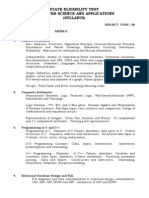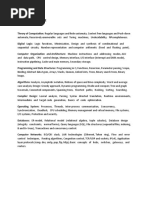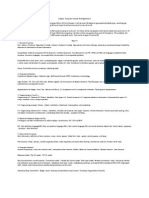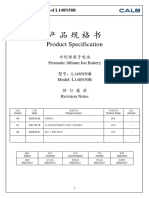0 ratings0% found this document useful (0 votes)
2 viewsComputer-Science-1
The document outlines the curriculum for Computer Science at Prior Pursglove College, detailing key topics such as data structures, algorithm complexity, and programming languages like VB.Net. It includes a comprehensive specification for the first year, covering areas like processor structure, systems software, software development methodologies, and networking. Additionally, it provides resources for further learning and contact information for the Computer Science teacher.
Uploaded by
musimwamunashe4Copyright
© © All Rights Reserved
Available Formats
Download as PDF, TXT or read online on Scribd
0 ratings0% found this document useful (0 votes)
2 viewsComputer-Science-1
The document outlines the curriculum for Computer Science at Prior Pursglove College, detailing key topics such as data structures, algorithm complexity, and programming languages like VB.Net. It includes a comprehensive specification for the first year, covering areas like processor structure, systems software, software development methodologies, and networking. Additionally, it provides resources for further learning and contact information for the Computer Science teacher.
Uploaded by
musimwamunashe4Copyright
© © All Rights Reserved
Available Formats
Download as PDF, TXT or read online on Scribd
You are on page 1/ 4
Computer Science
Progression to Computer Science at Prior Pursglove College
l Data Structures: Check the textbook: OCR A Level Computer Science, PM Heathcote and RSU Heathcote,
Chapter 7. This is the recommended textbook for the course and Chapter 7 gives an idea of one of the
more difficult areas.
l Algorithm Complexity (covers a large section of the theory content):
https://www.youtube.com/watch?v=RJw_2UiZkkc&list=PLCiOXwirraUDEHKiMKzXUlGLxKPRicn7I&index=2
l Visual Basic practice (this is the main language we use):
https://www.tutorialspoint.com/vb.net/index.htm
VB.Net Programming Tutorial – Tutorialspoint
VB.Net is a simple, modern, object-oriented computer programming language developed by
Microsoft to combine the power of .NET Framework and the common language runtime with the
productivity benefits that are the hallmark of Visual Basic.
www.tutorialspoint.com
l Expanded specification for the first year Computing Science
Area Spec. Ref Content
Structure and Function of the Processor 1.1.1 ALU, Control Unit, Registers, MAR,
MDR, CIR, PC, SR, ACC. FEC. CPU
performance factors. Caching, clock
speed, number of cores, pipelining.
Pipelining (advantages, disadvantages).
Buses (control, address, data). Von
Neumann, Harvard architecture
(comparison). Von Neumann
bottleneck.
Types of Processor 1.1.2 RISC and CISC (comparison). GPUS, use
of GPUs for non-graphic processing.
Multicore and Parallel processors
(types of parallel organisation)
Input, Output, Storage 1.1.3 Use of I/O devices in different
situations. Magnetic, flash and optical
storage.
RAM and ROM. BIOS. Bootstrapping.
Magnetic drives and solid state drives.
Virtual storage. Advantages and
disadvantages of virtual memory.
Speed of access to different memory
types.
Systems Software 1.2.1 Uses, functions of OS. Memory
management (paging, segmentation,
virtual memory.) Interrupts. Scheduling
algorithms. Device drivers. Virtual
machines. Types of OS (real-time,
multi-user, multi-tasking, distributed).
Utility software (examples).
Applications Development 1.2.2 Uses of applications for different
purposes.
Utilities. Open source vs closed source.
Translators -- compilers, interpreters
and assemblers. Java Byte Code, Java
Virtual Machine (advantages).
Comparison of compilers, interpreters
and Java Byte code. Stages of
compilation (lexical analysis, syntax
checking, optimisation). Linkers,
libraries.
Software Development 1.2.3 Waterfall cycle, Agile, Extreme
Programming, Spiral, RAD (comparison
of different methods). Stakeholders,
Requirements specification, success
criteria and measurement of criteria.
Validation. Algorithms. Testing (testing
strategies and test logs, test strategies
compared (advantages and
disadvantages). Data Dictionaries.
Entity-Relationship Diagrams.
Types of Programming Language 1.2.4 Procedural languages. 1GL, 2GL and
3GL. Low-level and high-level
languages. Advantages/
disadvantages of high-level and low-
level languages. Assembler (Little Man
Simulator). Object oriented languages.
Encapsulation, polymorphism,
inheritance. Advantages and
disadvantages of OO.
Compression, Encryption, Hashing. 1.3.1 Advantages of compression. Lossy and
Lossless Compression. When to use
lossy and when to use lossless.
Compression ratio. Asymmetric and
Symmetric Encryption compared.
Digital Signatures. Run Length and
Dictionary Encoding (when to use each
method). Hashing, hashing vs indexing.
Databases 1.3.2 Relational Databases, flat files
(disadvantages), primary key,
secondary key, foreign key.
Normalisation (1NF – atomicity of
data). Referential integrity. Entity
Relationship Diagrams, splitting M-to-
M relationships.
Networks 1.3.3 Characteristics of networks
(advantages, disadvantages), protocols
(why they’re needed). TCP/IP, DNS,
Protocol layering (advantages). LANs
and WANs, packet switching, circuit
switching. Network security. Error-
checking (different methods), proxy
servers. Network hardware (routers,
modems, switches, hubs – comparison
of different devices). Client-server,
peer-to-peer (comparison).
Web Technologies 1.3.4 HTML (know various tags), CSS (know
various tags), JavaScript (variables,
loops, IFs, functions). Uses of CSS and
JavaScript. Advantages/
disadvantages of CSS. Server and client
side processing (comparison). Page
Rank Algorithm. Search Page Indexing.
Data Types 1.4.1 Primitive (simple) data types. Positive
numbers in binary. Sign and Magnitude
and Twos complement. Positive
decimal conversions to binary and hex.
Fixed point fractions. Floating point
fractions, loss of precision with floating
point. Normalisation of fixed point
fractions (mantissa and exponent).
Disadvantages and disadvantages of
Fixed Point and Floating Point. ASCII
and Unicode
Data Structures 1.4.2 Primitive (simple) data types.
Composite data types. Dynamic and
Static data structures (comparison).
Arrays (1D to 3D), Records. Lists
(Python), Tuples, Stacks, Queues,
Trees. Add/remove elements from
stacks/queues. Add elements to binary
trees, (stored in sequence when
searched in-order)
Boolean Algebra 1.4.3 Define problems, propositions, subject,
predicate. Truth values, truth tables.
Tautologies, contradictions. Logical
connectors, logical equivalents. Logic
gates. Deriving Boolean expressions
from logic gates. Half-adder, full adder,
uses of adders. Karnaugh maps for 2,3
and 4 variables. Uses of K maps. K
maps for simplifying an expression. De
Morgan’s Law. Association,
distribution, commutation, double
negation for Boolean expressions.
Computer Legislation 1.5.1 Data Protection Act (terms). Computer
Misuse Act (three offences). Copyright,
Design and Patents Act. Regulation of
Investigatory Power Act (arguments for
and against)
Moral and Ethical Issues 1.5.2 Computers in the workplace – loss of
jobs, making work easier. Computers
making automated decisions –
Knowledge-Based Systems. Artificial
intelligence – good and bad aspects of
robots. Effects of computers on the
environment. Internet dangers
(trolling, cyberbullying, internet fraud,
terrorism, paedophilia). Checking on
behaviour using cyber techniques.
Storing personal information. Software
piracy. Design of websites (appropriate
use of colour, interfaces for disabled
access, character sets for foreign
languages.)
Thinking Abstractly 2.1.1 Need for abstraction (advantages).
Abstract models versus real (concrete)
situations. Use of abstraction in
different scenarios. Structure diagrams
used in abstraction. Control and data
abstraction.
Thinking Ahead 2.1.2 Inputs and outputs for a given
situation. Devising solutions to a give
problem. Caching. Reusability.
Thinking Procedurally 2.1.3 Breaking down problems into
manageable units (structure diagrams).
Use of procedures (modular approach -
- advantages).
Thinking Logically 2.1.4 Use of flow charts. Use of decision
points (IF conditions).
Thinking Concurrently 2.1.5 Concurrent vs parallel processing,
identifying parts of a program which
can be done concurrently, benefits and
disadvantages of concurrent
processing. Deadlock, starvation, race
conditions.
Programming Techniques 2.2.1 Program constructs -- sequence,
iteration, branching (selection, IF and
Case statements). Global, local
variables. Procedures and functions.
Parameters (passing by value and by
reference). IDEs. Object-oriented
techniques (advantages, disadvantages
of object orientation, encapsulation,
inheritance, polymorphism).
Readability of programs.
Computational Methods 2.2.2 Solving problems using computational
methods, things which the computer is
not good at. Problem recognition,
intractable problems, problem
decomposition (structure charts to
break down a problem). Divide and
conquer algorithms. Abstraction,
Backtracking, data mining, heuristics,
performance modelling, pipelining,
visualisation. Object oriented
techniques.
Algorithms 2.3.1 Design algorithms for given situation.
Algorithms for adding, deleting from
Stacks, Queues, Trees. In-order tree
traversal. Insert item into binary tree
(in-order sequence). Linear and Binary
search (compare). Bubble sort and
insertion sort (efficiency). Trace tables
for insertion sort and bubble sort. 2D
array algorithms, array of records
processing algorithms. File-processing
algorithms.
If you have any further questions please contact Computer Science Teacher Peter Li-Ping via
p.liping@pursglove.ac.uk
You might also like
- Aqa As and A Level Computer Science Heathcote P M Annas Archive 2100% (1)Aqa As and A Level Computer Science Heathcote P M Annas Archive 2412 pages
- Social Media Style Guide Template (To Use The Template, Click The - File - Tab and Select - Make A Copy - From The Drop-Down Menu)No ratings yetSocial Media Style Guide Template (To Use The Template, Click The - File - Tab and Select - Make A Copy - From The Drop-Down Menu)4 pages
- Y12 End of Year Computer Science Revision ListNo ratings yetY12 End of Year Computer Science Revision List4 pages
- Kerala PSC HSST Computer Science SyllabusNo ratings yetKerala PSC HSST Computer Science Syllabus5 pages
- Cambridge IGCSE 0474 Computer Science NotesNo ratings yetCambridge IGCSE 0474 Computer Science Notes2 pages
- State Eligibility Test Computer Science and Applications (SyllabusNo ratings yetState Eligibility Test Computer Science and Applications (Syllabus9 pages
- Computer Science: Instructor: Komal KhalidNo ratings yetComputer Science: Instructor: Komal Khalid58 pages
- BSC (IT) Part 1 Kolhan University Previous Year Papers and SyllabusNo ratings yetBSC (IT) Part 1 Kolhan University Previous Year Papers and Syllabus27 pages
- Computer Science: Instructor: Komal KhalidNo ratings yetComputer Science: Instructor: Komal Khalid51 pages
- Syllabus For Ph.D. Entrance Test Discrete StructuresNo ratings yetSyllabus For Ph.D. Entrance Test Discrete Structures4 pages
- Computer Science: Instructor: Komal KhalidNo ratings yetComputer Science: Instructor: Komal Khalid57 pages
- Computer Science / Information Technology: Details of Syllabus 1. Mathematical Foundations of Computer ScienceNo ratings yetComputer Science / Information Technology: Details of Syllabus 1. Mathematical Foundations of Computer Science12 pages
- Higher Secondary School Teacher (Junior) (Computer Science) Kerala Higher Secondary EducationNo ratings yetHigher Secondary School Teacher (Junior) (Computer Science) Kerala Higher Secondary Education5 pages
- Option - II Computer Science / Information TechnologyNo ratings yetOption - II Computer Science / Information Technology3 pages
- Computer Science Syllabus 2022 2024 f1s2sNo ratings yetComputer Science Syllabus 2022 2024 f1s2s5 pages
- Code No.:19 Subject: Computer Science and Applications: Syllabus and Sample Questions NoteNo ratings yetCode No.:19 Subject: Computer Science and Applications: Syllabus and Sample Questions Note8 pages
- Code No.:19 Subject: Computer Science and Applications: Syllabus and Sample Questions NoteNo ratings yetCode No.:19 Subject: Computer Science and Applications: Syllabus and Sample Questions Note7 pages
- UGC NET Syllabus 2018 For Computer Science and ApplicationNo ratings yetUGC NET Syllabus 2018 For Computer Science and Application9 pages
- Unified Syllabus B.Sc. / B.A Computer ApplicationNo ratings yetUnified Syllabus B.Sc. / B.A Computer Application10 pages
- 21 - M - SC - Computer Science &IT Syllabus (2017-18)No ratings yet21 - M - SC - Computer Science &IT Syllabus (2017-18)33 pages
- Subject: Computer Science and ApplicationNo ratings yetSubject: Computer Science and Application6 pages
- Syllabus For 3-Year B.Sc. (General) Course in Computer ScienceNo ratings yetSyllabus For 3-Year B.Sc. (General) Course in Computer Science7 pages
- Computer Science: Learn about Algorithms, Cybersecurity, Databases, Operating Systems, and Web DesignFrom EverandComputer Science: Learn about Algorithms, Cybersecurity, Databases, Operating Systems, and Web DesignNo ratings yet
- Function: Maintenance & Repair at Operational LevelNo ratings yetFunction: Maintenance & Repair at Operational Level2 pages
- CSE 6th Semester - Image and Video Analytics - CCS349 - NotesNo ratings yetCSE 6th Semester - Image and Video Analytics - CCS349 - Notes216 pages
- Modeling Extreme Events in Time Series Prediction: Daizong Ding, Mi Zhang Xudong Pan, Min Yang Xiangnan HeNo ratings yetModeling Extreme Events in Time Series Prediction: Daizong Ding, Mi Zhang Xudong Pan, Min Yang Xiangnan He9 pages
- Tuttnauer Manual Tecnico 5596 1R-EP SN18020808No ratings yetTuttnauer Manual Tecnico 5596 1R-EP SN18020808175 pages
- Detection of Cyber Attack in Network using Machine Learning Techniques (1)No ratings yetDetection of Cyber Attack in Network using Machine Learning Techniques (1)68 pages
- Research Report On Growth of Indian Telecom Sector: (Regulatory and Policy Initiatives)No ratings yetResearch Report On Growth of Indian Telecom Sector: (Regulatory and Policy Initiatives)20 pages
- 9852 2878 01 Maintenance Instructions COP1132BNo ratings yet9852 2878 01 Maintenance Instructions COP1132B42 pages
- Smart Mold: Real-Time In-Cavity Data AcquisitionNo ratings yetSmart Mold: Real-Time In-Cavity Data Acquisition8 pages
- Elementary Matrices and RREF: N N I Ij IjNo ratings yetElementary Matrices and RREF: N N I Ij Ij3 pages
- #4 Materi Regina Maria Hitoyo ESRI IndonesiaNo ratings yet#4 Materi Regina Maria Hitoyo ESRI Indonesia35 pages
- Ventilador Sechrist - Millenniun - Service Manual0% (1)Ventilador Sechrist - Millenniun - Service Manual64 pages
- Aqa As and A Level Computer Science Heathcote P M Annas Archive 2Aqa As and A Level Computer Science Heathcote P M Annas Archive 2
- Social Media Style Guide Template (To Use The Template, Click The - File - Tab and Select - Make A Copy - From The Drop-Down Menu)Social Media Style Guide Template (To Use The Template, Click The - File - Tab and Select - Make A Copy - From The Drop-Down Menu)
- State Eligibility Test Computer Science and Applications (SyllabusState Eligibility Test Computer Science and Applications (Syllabus
- BSC (IT) Part 1 Kolhan University Previous Year Papers and SyllabusBSC (IT) Part 1 Kolhan University Previous Year Papers and Syllabus
- Syllabus For Ph.D. Entrance Test Discrete StructuresSyllabus For Ph.D. Entrance Test Discrete Structures
- Computer Science / Information Technology: Details of Syllabus 1. Mathematical Foundations of Computer ScienceComputer Science / Information Technology: Details of Syllabus 1. Mathematical Foundations of Computer Science
- Higher Secondary School Teacher (Junior) (Computer Science) Kerala Higher Secondary EducationHigher Secondary School Teacher (Junior) (Computer Science) Kerala Higher Secondary Education
- Option - II Computer Science / Information TechnologyOption - II Computer Science / Information Technology
- Code No.:19 Subject: Computer Science and Applications: Syllabus and Sample Questions NoteCode No.:19 Subject: Computer Science and Applications: Syllabus and Sample Questions Note
- Code No.:19 Subject: Computer Science and Applications: Syllabus and Sample Questions NoteCode No.:19 Subject: Computer Science and Applications: Syllabus and Sample Questions Note
- UGC NET Syllabus 2018 For Computer Science and ApplicationUGC NET Syllabus 2018 For Computer Science and Application
- 21 - M - SC - Computer Science &IT Syllabus (2017-18)21 - M - SC - Computer Science &IT Syllabus (2017-18)
- Syllabus For 3-Year B.Sc. (General) Course in Computer ScienceSyllabus For 3-Year B.Sc. (General) Course in Computer Science
- Computer Science: Learn about Algorithms, Cybersecurity, Databases, Operating Systems, and Web DesignFrom EverandComputer Science: Learn about Algorithms, Cybersecurity, Databases, Operating Systems, and Web Design
- Building an Operating System with Rust: A Practical GuideFrom EverandBuilding an Operating System with Rust: A Practical Guide
- Function: Maintenance & Repair at Operational LevelFunction: Maintenance & Repair at Operational Level
- CSE 6th Semester - Image and Video Analytics - CCS349 - NotesCSE 6th Semester - Image and Video Analytics - CCS349 - Notes
- Modeling Extreme Events in Time Series Prediction: Daizong Ding, Mi Zhang Xudong Pan, Min Yang Xiangnan HeModeling Extreme Events in Time Series Prediction: Daizong Ding, Mi Zhang Xudong Pan, Min Yang Xiangnan He
- Detection of Cyber Attack in Network using Machine Learning Techniques (1)Detection of Cyber Attack in Network using Machine Learning Techniques (1)
- Research Report On Growth of Indian Telecom Sector: (Regulatory and Policy Initiatives)Research Report On Growth of Indian Telecom Sector: (Regulatory and Policy Initiatives)

























































































